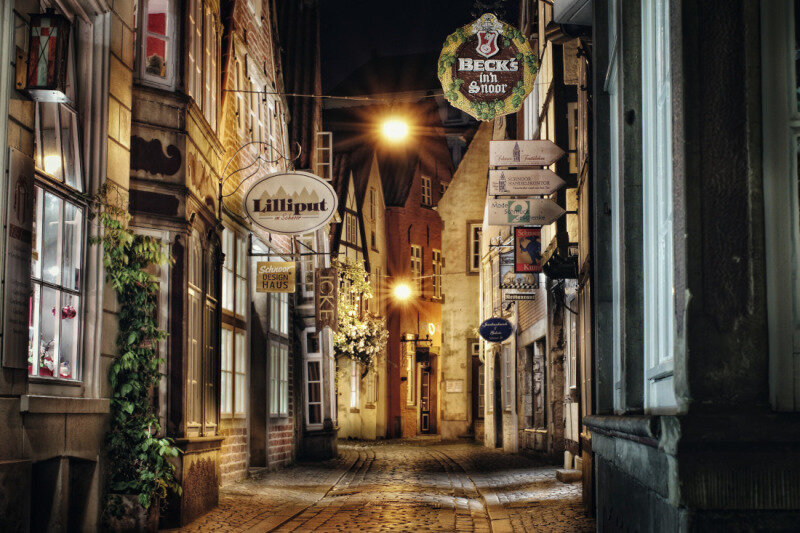
The charming medieval district of Schnoor, most commonly referred to as the "Schnoor Quarter," is named after the traditional rope-making trades that once flourished here. The oldest part of Bremen, it was once the poorest part of the city. The Schnoor was one of the poorer areas of Bremen, a Hanseatic city.
While the wealthy merchants moved in the Obernstraße (Upper Street), which was intended both geographically (dune ridge) and socially (Long Street, beside the Balge, Bremen's first port), the Schnoor grew as a fishing neighborhood in the 10th century. On the small island between the rivers Weser and Balge, the locals built thatched huts. As a result, it was vulnerable to high floods during its early centuries. Around the year 1240, the first ferry service was started, and the first bridge crossing the Weser was completed.
Near the so-called Marterburg, a historic wall and fragments of a round tower built around 1200 can be found. Franciscan friars settled in the 13th century, and their St. John's church was built in the following decades. The oldest houses in the area date from the 15th century. The majority of them date from the seventeenth and eighteenth century.

Unlike other districts of Bremen, where plots of around one square kilometer and merchant's villas were created, the Schnoor plots are just large enough for a single house on 55 square meters. The tiny streets were not designed to handle the rise in traffic that began in the nineteenth century. The district became one of Bremen's poorest areas, making restorations prohibitively expensive.
The Schnoor sustained very minor damage during WWII, thus house owners were required to pay a Lastenausgleich after 1945. However, by the mid-1950s, the residences had fallen into disrepair. In 1959, the Senate of Bremen's Free Hanseatic City decided to repair the Schnoor's historic district. House owners were encouraged to renovate dilapidated structures with financial assistance from the Bremen State. This growth contrasted with the common practice in many German and European towns and cities until the late 1970s.
The Venice Charter for the Conservation and Restoration of Monuments and Sites (1964) transformed the situation, and the Schnoor was designated as a historic district under formal cultural conservation by the State Monument Authority in 1973. The Schifferhaus on Stavendamm Street is one of the most notable houses that has been preserved in its original state. The Landherrnamt (1856), which formerly housed the officials managing the State of Bremen, is another significant structure. St. John's Church, a listed building with a history dating back to the 14th century, and the Birgittenkloster (Convent of Saint Birgitta), a modest Bridgettine convent founded in October 2002, are both located in the Schnoor.
Schnoor is currently a popular hangout for painters and other creative types, and it's a fascinating place to visit because of its numerous well-preserved 15th- to 18th-century residences. The Schifferhaus, or Shipper's House, is a gem among the various cafés and craft stores that now dot the region. It is now a private museum, having been built around 1630.
The magnificent Landherrnamt, which dates from 1856 and was originally home to the state administration and is remarkable for its well-preserved Neo-Romanesque exterior, is also worth a visit. St. John's Church, a Gothic church built of bricks in the 14th century, is also worth mentioning.
BY MUHAMMAD SHAHZAIB TAHIR AWAN (PAKISTAN) | CLASS OF 2022
